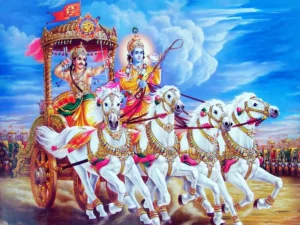 The Bhagavad Gita never advised that you should renounce everything, go to the forest and do penance. You may think, “Why preach Gita to these youngster?” You are afraid that if these people read Gita, they may give up family life and become renunciates. A small question. There are many elderly people who read and teach Bhagavad Gita regularly. Do they take to renunciation? No. You must get to the inner meaning of the Bhagavad Gita in order to understand human nature.
The Bhagavad Gita never advised that you should renounce everything, go to the forest and do penance. You may think, “Why preach Gita to these youngster?” You are afraid that if these people read Gita, they may give up family life and become renunciates. A small question. There are many elderly people who read and teach Bhagavad Gita regularly. Do they take to renunciation? No. You must get to the inner meaning of the Bhagavad Gita in order to understand human nature.
Bhagavad Gita — Its Greatness
In order to destroy the evil qualities in man like swarthatha (selfishness), raga (attachment), dwesha (hatred), mamakara (the feeling of mine) and ahamkara (ego), the Gita has assumed several forms and taught several types of yoga. It has provided solace and comfort to many people. It is like a kalpa vriskha (wish-fulfilling tree). It provides whatever meaning you wish to draw out of a sloka (verse) in it. No one has a right to interpret that this is the only meaning or that is the only meaning of a particular sloka. Who can decide that the kalpa vriksha (wish-fulfilling tree) should give only this fruit or that fruit? It gives whatever you desire. That is why,
“Gita is the messenger of God
Gita is the mother to the entire Universe
Gita is the support to a spiritual aspirant
Gita is the cleaning gear for the householder
Gita is the repository of mantras
Gita is the spring of Vedanta
Gita is a beautiful path of flowers
Gita is the right royal path
This is the declaration of Sri Sai”
Gita – To Everyone According to One’s Perception
In Bhagavad Gita, everyone will get the meaning as per one’s mental perception. A short while ago Balaraju recited a sloka on Lord Vinayaka:
“Suldaambaaradharam Vishnum
Sasivarnam chathurbhujam
Prasannavadanam Dhyaayeth
Sarvavighnopa saanthaye ”
According to the description in this sloka, “Lord Vinayaka wears white cloth. The word vishnu means, the all-pervading. He is Omnipresent. His colour is that of the moon. He has four arms. He has always a pleasant face. He is neither elated nor depressed. He is beyond joys and sorrows”. Thus devotees pray to Him. This description of Lord Vinayaka is made by the asthikas (theists or people who believe in the existence of God). The same sloka is interpreted by the nashikas (athiests or non-believers in God) in a different way. “Suklaambaradharam” (one that carries white clothes); “vishnam” (to be found everywhere) “sasivarnam” (of brown colour) “chaturbhujam” (the four-legged) prasanna vadanam (always cheerful) — that is, the donkey. Similarly, the Bhagavad Gita also gives many meanings to many people. To each one, according to his or her perception. The Bhagavad Gita is not an ordinary vriksha (tree). It is a kalpa vriksha (the wish-fulfilling tree). It is kama dhenu (the wish-fulfilling cow). Each one can take his own meaning of the slokas.
The ocean consists of infinite quantity of water. Each one can draw as much quantity of water as his vessel permits. There may be difference in the capacities of the vessels, but water is the same. Our thoughts, feelings and perceptions may differ. But, the Bhagavad Gita is one and the same. The Gita transforms human nature into divinity and establishes the atma-tattva (the principle of Brahman). Therefore, do not slight the teachings of Bhagavad Gita. Study it with faith and devotion. Understand the correct meaning of the various concepts and put into practice at least one or two. Then only these Gita Parayana (reading of the text of Giza systematically) and Gita bodha (the teaching of Gita), will become fruitful.

![]()

